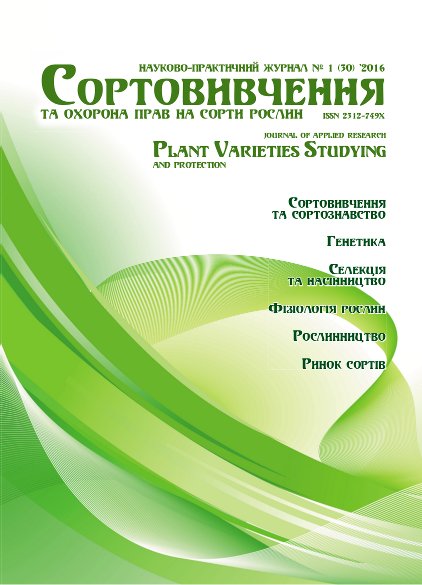Spring triticale yield and its stability depending on the genotype and environmental conditions
DOI:
https://doi.org/10.21498/2518-1017.1(30).2016.61765Keywords:
spring triticale, yield, adaptability, stability, drought resistance, variety, lineAbstract
Purpose. Assessing stability of yield formation of complex-valued varieties and lines of spring triticale under conditions and of different years of their growing. Identifying the best genotypes for yield potential, plasticity and stability. Methods. Ontogenetic, statistical and mathematical analyses. Results. Adaptive capacity and breeding value of spring triticale varieties and lines was established. Methods of breeding and parentage of the best samples were analyzed. Comparison of yields under conditions in of different years of growing allowed to identify genotypes with high yield potential – ‘ЯТХ 38-14’, ‘ЯТХ 61-14’, ‘ЯТХ 62-14’, with stable yields – ‘ЯТХ 17-14’, ‘Boryviter kharkivskyi’, ‘ЯТХ 43-14’, ‘Gusar kharkivskyi’, drought resistance ones – ‘ЯТХ 37-14’, ‘ЯТХ 43-14’, ‘ЯТХ-64-14’. The genotypes ‘Lebіd kharkіvskyi’, ‘ЯТХ 38-14’, ‘ЯТХ 62-14’ appeared to be more plastic. These samples may be used of hybridization to improve yield. Conclusions. The most promising to production and breeding are the lines ‘ЯТХ 17-14’, ‘ЯТХ 64-14’, ‘ЯТХ 37-14’, ‘ЯТХ 43-14’ (their average yield 4,27–4,48 t/ha) and varieties ‘Zlit kharkivskyi’, ‘Boryviter kharkivskyi’, ‘Gusar kharkivskyi’, ‘Darkhliba kharkivskyi’, which have high adaptive capacity combined with high productivity. They are valuable for use as a starting material in breeding for adaptability.
Downloads
References
Grabovets A. I., & Fomenko, M. A. (2013). Sozdanie i vnedrenie sortov pshenitsy i tritikale s shirokoy ekologicheskoy adaptatsiey [Release and introduction of varieties of wheat and triticale with wide ecological adaptation]. Zernobobovye i krupyanye kul’tury [Leguminous and groat crops], 2, 41–47 [in Russian].
Grib, S. I., & Ponomarev, S. N. (2011). Otsenka belorusskikh sortov ozimoy tritikale po adaptivnosti i produktivnosti [Assessment of the Belarusian varieties of winter triticale varieties for their adaptivility and productivity]. Nauchnye prioritety innovatsionnogo razvitiya otrasli rastenievodstva: rezultaty i perspektivy: materialy Mezhdunar. nauch.-prakt. konf. [Research priorities for the innovative development of plant industry: results and prospects: Proceedings of the International Scientific and Practical Conference]. (рр. 171–175). Zhodino: N.p. [in Russian].
Goyal, A., Beres, B. L., Randhawa, H. S., et. al. (2011). Yield stability analysis of broadly adaptive triticale germplasm in southern and central Alberta, Canada, for industrial end-use suitability. Can. J. Plant Sci., 91(1), 125–135.
Fox, P. N., Skovmand, B., Thompson, B. K., Braun, H.-J., Cormier, R. (1990). Yield and adaptation of hexaploid spring triticale. Euphytica, 47(1), 57–64.
Vladimirskiy NIISKh FANO Rossii (ofitsialnyy sayt). Laboratoriya adaptivno-ekologicheskoy selektsii [Vladimir Agricultural Research Institute (official website). Laboratory of Ecological and Adaptive Breeding]. Retrieved from: http://vnish.org/laboratoriya-adaptivno-ekologicheskoj-selektsii.
Riabchun, V. K., Kapustina, T. B., & Melnyk, V. S. (2012). Metody stvorennia vykhidhnoho materialu trytykale yaroho, adaptovanoho do nespryiatlyvykh umov vyroshchuvannia [Methods for creating source material of spring triticale adapted to unfavourable growing conditions]. Selektsia i nasinnitstvo [Selection and Seed Industry], 102, 41–50 [in Ukrainian].
Dospekhov, B. A. (1985). Metodika polevogo opyta (s osnovami statisticheskoy obrabotki rezul’tatov issledovaniy) [Methods of field experiment (with the basics of statistical processing of research results)]. (5nd ed., rev.). Moscow: Agropromizdat [in Russian].
Kilchevskiy, A. V., & Khotyleva, L. V. (1989). Genotip i sreda v selektsii rasteniy [Genotype and Environment in Plant Breeding]. Minsk: Nauka i tekhnika Publ. [in Russian].
Kilchevskiy, A. V. (2005). Genetiko-ekologicheskie osnovy selektsii rasteniy [Genetic and Environmental Basics of Plant Breeding]. Vestnik Vavilovskogo Obshchestva Genetikov i Selektsionerov [Bulletin of Vavilov Society of Geneticists and Breeders], 9(4), 518–529 [in Russian].
Eberhart, S. A., & Russell, W. А. (1966). Stability parameters for comparing varieties. Crop. Sci., 6(1), 36–40.
Downloads
Published
How to Cite
Issue
Section
License
Copyright (c) 2016 Ukrainian Institute for Plant Variety Examination

This work is licensed under a Creative Commons Attribution-ShareAlike 4.0 International License.
Starting in 2022, the copyright to the publication remains with the authors
Our journal abides by the CREATIVE COMMONS copyright rights and permissions for open access journals.
Authors, who are published in this journal, agree to the following conditions:
- The authors reserve the right to authorship of the work and pass the first publication right of this work to the journal under the terms of a Creative Commons Attribution License, which allows others to freely distribute the published research with the obligatory reference to the authors of the original work and the first publication of the work in this journal.
- The authors have the right to conclude separate supplement agreements that relate to non-exclusive work distribution in the form in which it has been published by the journal (for example, to upload the work to the online storage of the journal or publish it as part of a monograph), provided that the reference to the first publication of the work in this journal is included.

























 Ukrainian Institute for Plant Varieties Examination
Ukrainian Institute for Plant Varieties Examination  Селекційно-генетичний інститут
Селекційно-генетичний інститут Institute of Plant Physiology and Genetics of the National Academy of Sciences of Ukraine
Institute of Plant Physiology and Genetics of the National Academy of Sciences of Ukraine
 The National Academy of Agrarian Sciences of Ukraine
The National Academy of Agrarian Sciences of Ukraine